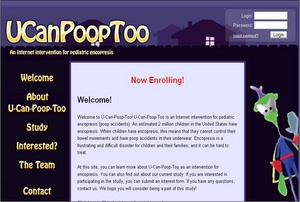U-Can-Poop-Too (USA)

- Description:
The U-Can-Poop-Too program uses enhanced toilet training (ETT), a behavioural treatment that provides education, modelling and reinforcement to promote control over bowel movements, and medical management. It is an interactive program for children and their parents, using illustrations, animated tutorials, quizzes and audio. There are three sections: 3 core modules, additional modules and follow-up. The first core module provides education on the anatomy and physiology of bowel movements and includes a tour of the gastrointestinal tract. The second focuses on medical treatments, and the third discusses behavioural intervention. The latter provides instruction on defecation dynamics and how to have a bowel movement on the toilet and how not to (by teaching straining and relaxing). These core modules take 60-90 minutes. The program then recommends a selection of 22 additional modules (covering related topics such as diet and hygiene) taking 5-10 minutes each. Modules are assigned based on data entered by the user in the follow-up questionnaire which is completed weekly for three weeks. Users can then complete follow-ups at any time.
- Service URL:
- http://www.ucanpooptoo.com
- Agency Responsible:
- University of Virginia.
Details
- Format:
- Website.
- Intervention Type:
- Other. Utilises Behavioural strategies
- Course Length:
- Long (more than 5 modules). Comprises three core modules and a variety of additional modules
- Support Option:
- Automated only.
Target Audience
- Primary Category:
- Encopresis and Enuresis.
- Target Audience:
- Child.
- Language:
- English.
Access
- Fee:
- Fee-based.
- Access:
- Closed: Fee required.
- Contact Details:
Research evidence
- Research Trials:
- 5
- Research RCTs:
- 1
- Outcome Summary:
The U-Can-Poop-Too program has been evaluated in an RCT comparing children who receiving routine care plus the program on the internet with a control group who receive routine care only. This study found that the program resulted in significant improvements compared to the control group. The number of accidents reduced from one per day to one every two weeks, a reduction not apparent in controls. Further, the number of bowel movements in the toilet each week increased, while for controls this outcome variable decreased. Children completing the program over the internet also increased their use of the bathroom with and without prompting from their parents, while the control group showed reductions in their use. In a subsequent RCT, those families provided access to U-Can-Poop-Too who reported higher baseline levels of worry about their child’s health reported greater use of the intervention. In a ‘real world’ study, in which patients were provided access to the program as part of face-to-face treatment, parents rated the Internet program as “enjoyable, understandable, and easy to use,” and indicated the Internet program was an important element of treatment. The utility of program components has also been investigated, with audio, graphics and interactivity shown to have a positive effect on encopresis internet intervention outcomes. Email prompts have also been shown to be an important element to help overcome barriers of adherence.
- Recommended rating, reviewer 1:

- Recommended rating, reviewer 2:

Read more about Beacon's Smiley Rating System.
Research paper citations
Efficacy studies
- Borowitz, S. M. & Ritterband, L. M. (2001). Using the Internet to teach parents and children about constipation and encopresis. Medical Informatics and the Internet in Medicine, 26(4), 283-295. PMID: 11783712.
- Ritterband, L. M., Cox, D. J., Walker, L. S., Kovatchev, B., McKnight, L., Patel, K., Borowitz, S., & Sutphen, J. (2003). An Internet intervention as adjunctive therapy for pediatric encopresis. Journal of Consulting & Clinical Psychology, 71, 910-917.
- Ritterband, L. M., Borowitz, S. M., Cox, D. J., Kovatchev, B., Walker, L. S., Lucas, V., & Sutphen, J. (2005). Using the Internet to provide information prescriptions. Pediatrics, 116, e643-e647.
- Ritterband, L. M., Cox, D. J., Gordon, T. L., Borowitz, S. M., Kovatchev, B. P., Walker, L. S., & Sutphen, J. L. (2006). Examining the added value of audio, graphics, and interactivity in an Internet intervention for pediatric encopresis. Children's Health Care, 35, 47-59.
Additional References
- Ritterband, L. M., Ardalan, K., Thorndike, F. P., Magee, J. C., Saylor, D. K., Cox, D. J., Sutphen, J. L., & Borowitz, S. M. (2008). Real world use of an Internet intervention for pediatric encopresis. Journal of Medical Internet Research, 10(2): e16.
- Magee, J. C., Ritterband, L. M., Thorndike, F. P., Cox, D. J., & Borowitz, S. M. (2009). Exploring the relationship between parental worry about their child's health and usage of an Internet intervention for pediatric encopresis. Journal of Pediatric Psychology, 34, 530-538.
User ratings
User ratings and comments are moderated in order to assure the quality of the submissions. It might take a week for your rating to show up.
Your rating
Login to rate this service.
Other user ratings
No ratings for this service yet.
Last Updated: August 19th 2014

 Home
Home
 Categories
Categories Encopresis and Enuresis
Encopresis and Enuresis